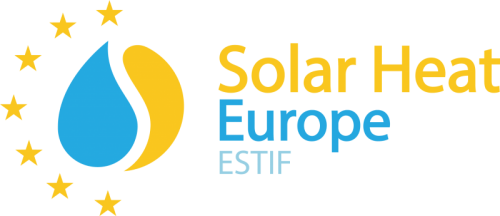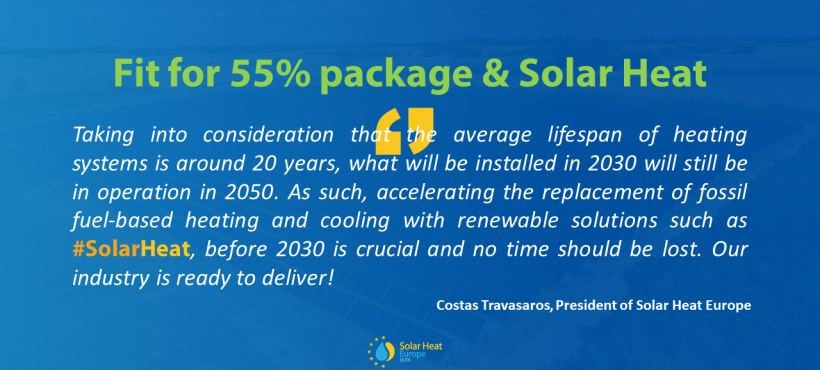Brussels, 14th July 2021 – The Solar Heating & Cooling sector welcomes the European Commission’s Package to reduce our greenhouse gas emissions by -55% net by 2030, while highlighting the importance to push for a more ambitious and faster transition towards 100% renewable energy overall, particularly through solar thermal heat.
The European Commission published today the FitFor55 Package, which revises more than 10 legislative files to bring them in line with the new ambitions of the European Union’s Green Deal, the increased targets for 2030, and a climate-neutral Europe by 2050. This Package covers a wide array of areas, from energy taxation to building renovation and a transition towards using only renewable energies.
The Solar Heat industry welcomes the outstanding work that has gone into developing the FitFor55 Package, an initiative that makes the EU a role model in the global scene of climate action and decarbonisation. Our sector strongly supports an increased climate ambition and is ready to play an important role in achieving the proposed targets.
“The current climate disasters happening around the world are the clearest sign that we cannot trifle with our carbon budgets anymore. Heat represents half of the energy consumed in Europe and worldwide, the time to make bold moves for renewable heat solutions is now.” said Costas Travasaros, President of Solar Heat Europe.
As part of the package, the revision of the Renewable Energy Directive (RED III) proposes new tools to households and industry alike and it increases the EU’s industrial security as it de-risks investments in the renewable transition. For private households, it encourages the planned replacement of old and inefficient heating and cooling systems with systems using renewable energy, phasing out support for fossil fuels. In addition, it also increases transparency by providing consumers with more information about their energy mix and related GHG emissions, to encourage a swift transition towards renewable alternatives, such as solar thermal heat, already installed in over 10 million homes in the EU. For industry it encourages the use of renewable solutions, increasing the commitment to decarbonise industrial processes, namely using more renewable heat.
“Taking into consideration that the average lifespan of heating systems is around 20 years, what will be installed in 2030 will still be in operation in 2050. As such, accelerating the replacement of fossil fuel-based heating and cooling with renewable solutions such as solar heat, before 2030 is crucial and no time should be lost. Our industry is ready to deliver!”, Mr. Travasaros added.
Therefore, the time to take bold policy steps towards the green transition for heating and cooling is now. To stay within +1.5oC temperature increase target it is essential to have a drastic increase in the uptake of renewable heat. Having this in mind, the targets for renewable heat should be higher, increasing from the 1.1 percentage points proposed to 3.1. We welcome the ambition for buildings to reach the benchmark of 49% renewables and stress that this goal should be complemented by a 6% annual replacement target of old and inefficient heating and cooling appliances with new efficient and renewable solutions. We also support the proposed targets for district heating networks and industry (the proposed target of an annual increase of respectively, 2.1 and 1.1 percentage points), noting that these targets should be made binding.
Decentralised renewable energy solutions like Solar Heat can bring a real impact already today if supported properly through the right policy framework. The solar thermal industry is ready for this transition, as IRENA’s +1.5oC pathway requires global solar thermal capacity to increase from 480 GWth in 2018, to 890 GWth in 2030, and 1 300 GWth in 2050. Likewise, IEA[1] foresees in their Net Zero by 2050 scenario that the number of households with solar thermal globally shall increase from 250 million in 2020 to 400 million in 2030 and 1 200 million by 2050.
The potential of our sector to contribute to decarbonisation in Europe is relying on the adequate measures and ambition in the Fit for 55 Package. To this end, renewable heating and cooling sources, already available in the market, must be treated on a level playing field and be deployed immediately to ensure a diversity of supply for energy consumers at all levels, including industries, districts, and buildings. Solar thermal heating and cooling is already cheaper than electrification. According to IRENA[2], the average solar heat cost[3], related to the supply of district heating in Denmark, fell from $0.066/KWh (2010) to $0.045/KWh (2019) and installation costs in Austria and Germany have dropped by 45%-55% in the past 7 years. Ensuring sufficient funding into renewable heating and cooling, and especially for solar thermal heat, will also lead to economies of scale which will continue to decrease the price of heating and cooling.
In the words of Jean Monnet: “everybody is ambitious, the question is whether we are ambitious to be or ambitious to do”. For our climate, societies, and renewable industries, we must dare to be ambitious to do.
About Solar Heat Europe/ESTIF
Solar Heat Europe/ESTIF’s mission is to achieve the prioritisation and acceptance of solar heat as a key element for sustainable heating and cooling in Europe and to work for the implementation of all necessary steps to realise the high potential of solar heat. With members in more than 15 European countries, Solar Heat Europe represents directly or indirectly over 90% of the industry, across the value chain.
Contact:
Pedro Dias, Secretary General
Tel: +32 2 318 40 55
Alexandra Sutu, Communications Officer
alexandra.sutu@solarheateurope.eu
Tel: +32 474 94 09 81
[1] International Energy Agency (IEA), IEA World’s Roadmap to Net Zero by 2050, 2021
[2] International Renewable Energy Agency (IRENA), Renewable Power Generation Costs in 2020, 2021.
[3] Levelised cost of heat, LCoH


Leave a Reply